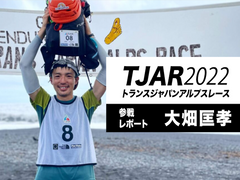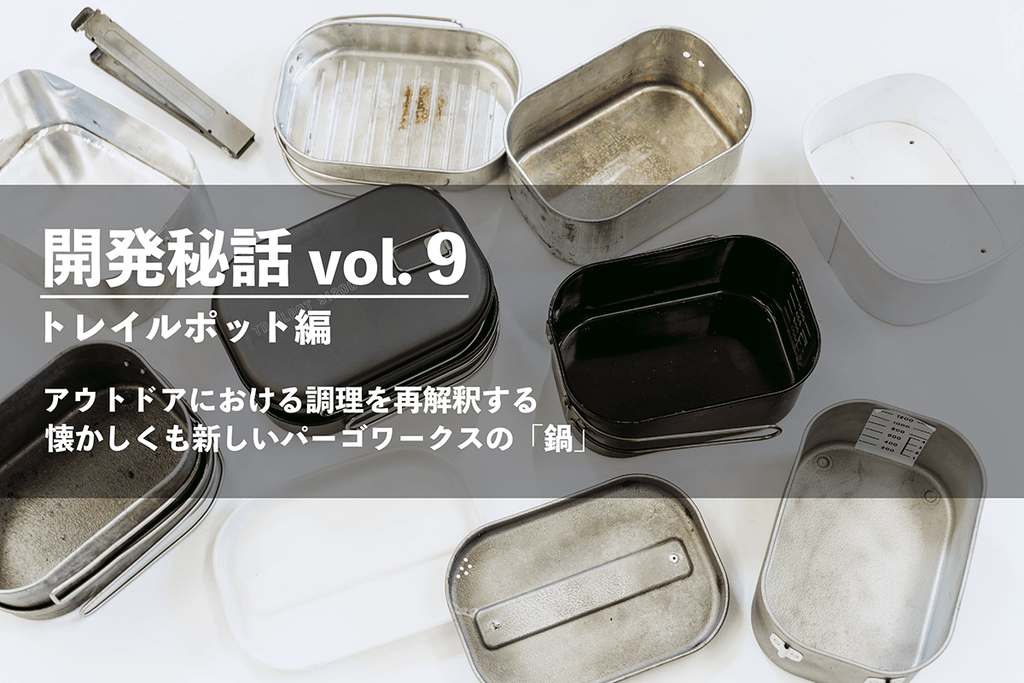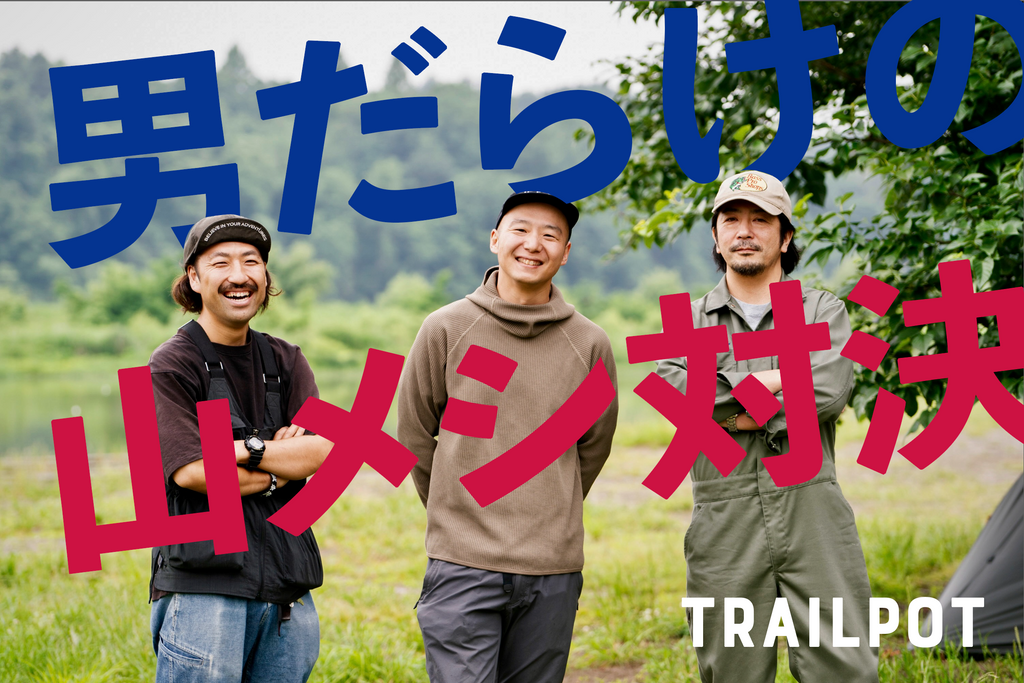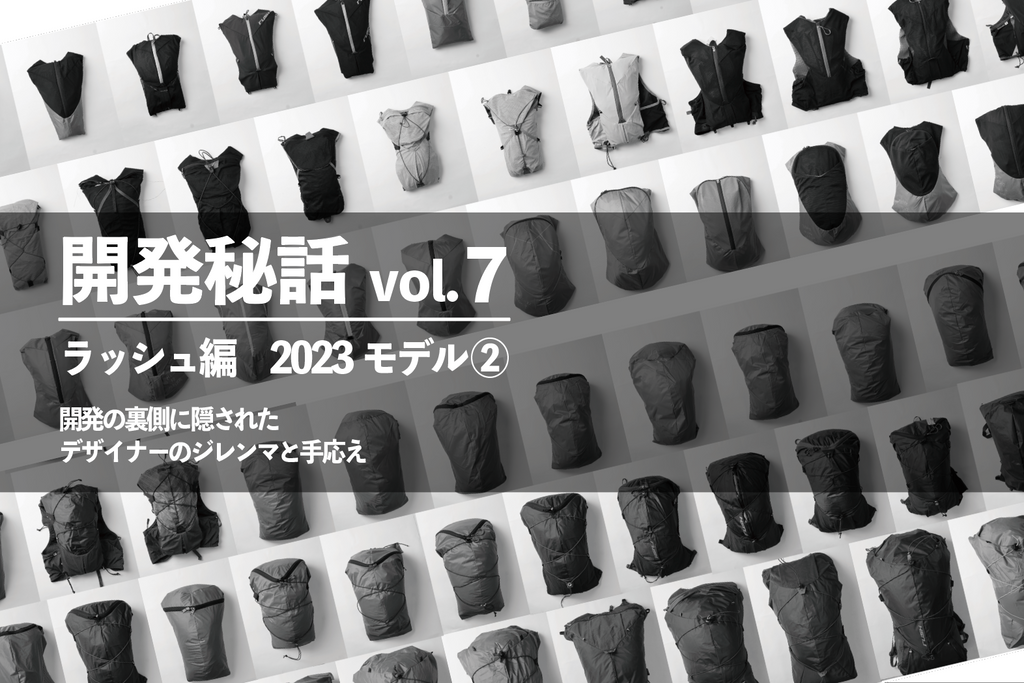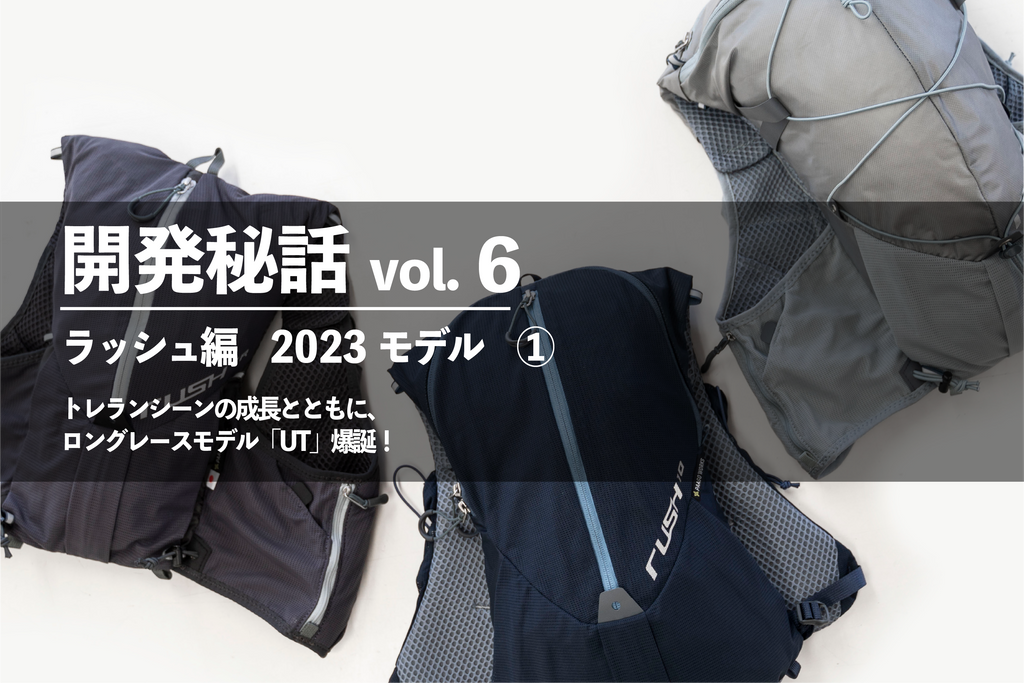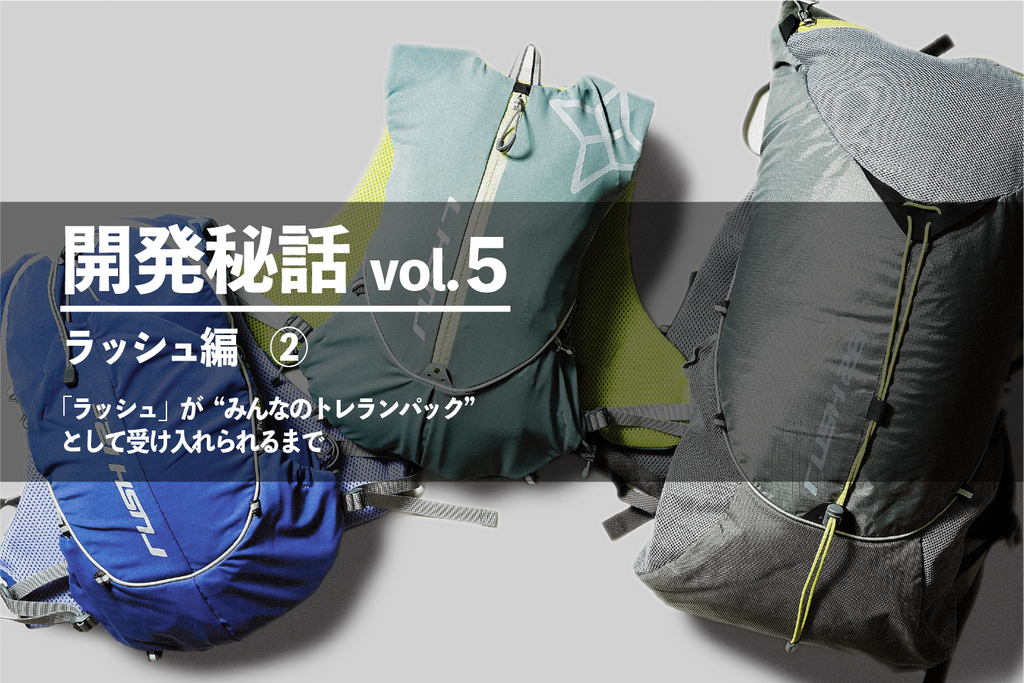MAGAZINE

Product History vol.4 Rush Series (Part 1)
The eve of the birth of “Rush”, which contains the heat of the dawn of trail running culture
"Development secret story" 4th is the backpack series for trail running "RUSH". Based on the design that fits the Japanese body type, we have developed a variation model that corresponds to everything from mountain races to road running, and has been supported by many runners since its release in 2012.
I would like to look back on the development background of the "Rush" series. In addition, "Rush Edition" is scheduled for all three times, and this time we will deliver the story before the establishment of Pergo Works from 1996 to 2010.

―It has been about 10 years since the first model of “Rush” appeared. Therefore, I think that today's users are chasing the "derivative" part of the product. So, I would like to start by asking about the "origin".
In common with the story of "Pathfinder", even before 2011 when you started Pergo Works, you were making products that lead to the current "Rush" series. Since it's a big deal, let's look back from there.
Speaking from the beginning, it goes back to the early 90's, but at that time it was the dawn of trail running. Running in the mountains and nature = trail running was not a major activity like it is now, but a pastime for core people. As a word, it would be more appropriate to call it an adventure race instead of trail running. The Hasetsune (Japanese Mountain Endurance Race Tsuneo Hasegawa Cup) started in 1992, and it was the era when trail running was born in Japan.
At that time, I was still a player rather than a designer. I participated in Hasetsune about four times, and at the same time I participated in adventure races held in Japan as a support, experiencing the scene right in the middle. When the world's first adventure race, the Raid Gauloises, was held on the Nagara River in Gifu, there was an aerial view of the river descent from a helicopter, and there were participants from overseas. be. I think it's easier to understand if you imagine the excitement of the current UTMB (Ultra Trail du Mont Blanc).
But I wasn't all that excited.
Because when it comes to adventure races, I've seen the "real world" overseas, so I thought, "It should be cooler." When I went to see the Southern Traverse race in New Zealand, the field was overwhelmingly beautiful, the style of the runners was cool, and the gear they were using was something I had never seen before.
On the other hand, whether it was adventure racing or trail running, it was a time when Japan's outdoor scene wasn't yet cool. However, there was a moment of excitement in the scene, and I started to feel like I wanted to make backpacks as a designer, and to create a culture that was cooler than the original.
―Do you feel that by participating as a player in Japan, you experienced the excitement, and by learning about the overseas scene, you began to see a vision? At that time, I think you were already designing backpacks as an external designer for an outdoor manufacturer, and it was around that time that you launched your own brand.
At that time, I met a person who runs an endurance race called "Journey Run". About 50km a day, 1000km would take 20 days. The race in Hokkaido is 500km from Tomakomai to Wakkanai and 1000km after returning.
I was in the journey run as a supporter, but it was already a messed up race, and the life of a runner could be glimpsed. As an aside, that race was also a drama called "Angel's Marathon Shoes", and I also made a backpack for filming it (laughs).
Around that time, he became an independent designer and started a backpack manufacturer with Aki (Toru Saito's wife). The brand name is "Journey Junkey".
"Journey Junkey" also appears in "Development Secret Story Chest Bag Edition", but the chest bag was only for personal use and was not a product for sale. These were custom-made and sold to runners who participated in races and competitions. It is also the first item that I made and sold by myself to make a living.

The reason why I wanted to make this "Journey Junkey" was that when I saw runners, backpacks didn't necessarily fit well, and my luggage was shaking. Especially in Hasetsune, there were many people who came out with a daypack like a knapsack, and there were almost no backpacks specifically for running like now.
As a designer, I wanted to do that. Of course, I was also a player, so I also wanted to use it myself.
―Finally, it's starting to look like a "development secret story". What kind of backpack manufacturers were there at the time?
I was working hard on ULTIMATE DIRECTIONS and MACPAC. UD was cool but heavy. However, the way of thinking was completely new, and the shoulder harness was made independently so that the shoulder blades can be freed when running, and the design was designed so that the load could be carried on the back. The products also changed their models every year, and they were changed to the extent that "Isn't the design concept reset?!" It was very interesting, and I felt the freedom of manufacturing.
The scene was just growing, and I witnessed the evolution of tools with my own eyes. So, while receiving external stimuli, I wanted to make a custom-made backpack, "Journey Junkey".

―Even though you launched the brand, how did you sell it?
It was a very analog activity, going to events, briefings, and debriefing sessions, handing out order sheets and asking for orders. When I went to the venue with a sample backpack, the organizer introduced me, saying, ``Mr. Saito, who makes backpacks, is here today.'' Then the runners would gather and say, "Eh, who are they?" (laughs).
It feels like having people actually carry it on their back and ordering it from people who like it. The order sheet allows you to choose the specifications of the pocket and the color of the fabric, and it also accepts detailed customization. Pockets are also mesh Velcro specifications or fabric zipper specifications.
At that time, the only way to communicate was by e-mail, and I don't think they even created a website. I don't rely on the internet that much, it's more like talking face-to-face, showing a sample, and getting an order. and ship it when it's done. Together with Aki, I sewed them one by one with a sewing machine, and I think I made about 200 of them.
However, as I was doing it, I realized that I couldn't make the same product because I improved it while making it (laughs). In the end, I repeated version upgrades frequently and ended up with ver.8. I wonder if it was a generous era that can't be thought of now. I would like to share my trial and error as well. However, the manufacturer is irresponsible.
This method is primitive, but what we are still doing is not that different. We have stalls at events like OMM and trail running, and I like communicating with customers at the booth.

―You've been doing something like a garage maker for over 20 years.
oh yeah. Since I was in my twenties, I had a dream of becoming a garage maker. I also knew that there was a Rookie booth at the OR show (an outdoor exhibition held in the United States), with garage brands lined up.
I love the outdoors and I love making things, so I was thinking about how I could make a living from it. That flow leads to "Journey Junkey".
However, there is a word "garage maker" nowadays, but at that time there was no such fashionable word, and there was not as much information as now.
―Could you show us that “Journey Junkey”?
Looking at it now, it doesn't look fresh, but the point is that the luggage doesn't sway. The use of trekking poles was just beginning to be recommended, so I attached holders. The mesh material is for ventilation because it gets messy with mud and sweat in adventure races. I think it was sold for about 13,000 yen, with a feeling of size that was barely enough to run Hasetsune.

There is no storage in the front because hydration was still the main thing. Energy bars like Calorie Mate were the norm, and gels weren't that popular. I didn't think much about lightness yet, so I used a plastic frame built-in, strength priority, and a stiff buckle. I think it's been about 5 years since I started thinking about weight reduction with trail running packs.
The waist belt is inspired by a medical lumbar support, which is a remnant of when I was riding a motorcycle and knew how comfortable it would be to have a waist belt. The era when there was still no answer as a backpack design for running. Of course, I'm still in the process of searching, but I think I like the act of using my head, using my body, talking to people, and searching for answers.

So, another one is this design that turned upside down. I turned it upside down because I wanted to raise the center of gravity. And since there is a distance between the shoulders and the waist, the waist belt will inevitably play with it, so if the back is soft, the waist position is raised so that there is no gap in the back, and it is fastened around the ribs.

At the time, it was popular to carry it on your back, but I thought that the priority for a trail running pack was not to put the weight on the hips, but to suppress the shaking and fit it to the body. This idea has been passed down to the current "Rush" series.
The theme of a backpack for running doesn't change, and the human body doesn't change either. What has changed is the way they play and the tools they use. What I want is universal, and it's nice to be comfortable and stress-free. This was my answer at the time. And while I was thinking about comfort and functionality, what I had in mind was the coolness I saw in overseas adventure races. Instead of imitating it, I wanted to make a cool backpack from Japan.

―In this way, Journey Junkey has joined the ranks of manufacturers as a garage brand, but the fact that you are now working as Pergoworks instead of continuing as it is means that there was a turning point.
As I talked a little about in "Development Secret Story Chest Bag Edition", it was around the time I started to realize that I wasn't cut out to be a producer. It's fun to make, but I want to do "development". It was also at this time that I decided that if I were going to run a brand, I would have to set up a solid production system and create an environment where I could devote myself to development as a designer. However, although Pergo Works was a long way off, I was chasing the trail running culture as "Journey Junkey" until around 2010.

